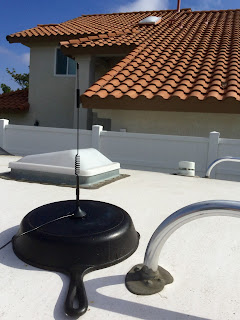We have a barely adequate signal with Verizon at our residence. The booster is not providing a 'super' boost but it is definitely improving the signal. How much? Read on.
 |
| Communication Cabinet Power |
 |
| weBoost 4G-M and iPhone in Hot Spot Mode Placed on Internal Antenna |
With the booster off the iPhone showed 2 bars of signal from inside the trailer.
The bars do not indicate just signal strength however. The indicator reflects other aspects of the connection based on some mystery iOS algorithm. To get a reading of just signal strength in db you need to put the iPhone into Field Test mode. This provides a measure of only signal strength. -115 db is a very poor signal. -55 db would be a very strong signal.
Without the booster the iPhone was receiving a -107 db cell signal.
 |
| Without Booster: 2 Bars |
 |
| Without Booster: -107 db |
 |
| With Booster: -90 db |
Great, we have an improved cell signal, but the iPhone is now inconveniently located in a little 'communication' cabinet. That is where the iPhone's role as the amazing Arctic Fox mobile Wi-Fi hot spot comes in.
To test this part of the system the Wi-Fi router in the house was turned off so that there would be no doubt that the iPhone only had internet access through Verizon cellular. An iPad was connected to the iPhone Wi-Fi. This worked perfectly and internet surfing through Verizon commenced immediately. The connection was used to download the Speedtest app. Similarly, any of our other devices can now simultaneously share this local wireless network and access the internet through our Verizon data plan. By using Skype on the iPad calls can be placed to anywhere in the world for free or just a few cents per minute when the iPhone is busy providing internet and Wi-Fi service. Either of our iPhones can serve as our Wi-Fi hot spot so one of our phones is always free for normal use.
 |
| iPad Connected to iPhone Hot Spot |
So, with the boosted signal was the internet access speed good enough to get along when on the road? Here are the speed test results:
 |
| Cellular Data Download Speed from iPad thru iPhone Hot Spot |
 |
| Cellular Data Upload Speed to iPad thru iPhone Hot Spot |
We now have local Wi-Fi around the trailer with internet access wherever there is at least marginal Verizon cell coverage, including international roaming in Canada and Mexico for an additional $2/day as needed. All of this powered by our solar charged trailer batteries. Time to increase the data plan limit - we are going mobile. Don't be surprised when you get a Skype or FaceTime video call from us from the middle of nowhere.


now we just need that 5.9 chipped to double its tq output!!
ReplyDeleteI liked the use of the "removable" cast iron skillet as a plane for the antenna best. While it would be funny if you drove off with that on the roof, I have every confidence you will install a permanently placed plane before you go. :)
ReplyDeleteI will take a Skype call any time from you guys!
ReplyDeleteKen, you two have done an amazing job of research and preparation for this trip. I look forward to seeing you and your wonder machine soon.
ReplyDeleteThanks for the comments everyone. Look for a follow up post on the replacement of the cast iron ground plane. Hint: the new solution still involves cookware.
ReplyDeleteCookie sheet?
ReplyDeleteThat was an option, but we found almost everything to be aluminum or stainless steel. These materials probably work reflecting radio waves, but the antenna has a magnetic base. To hold the antenna down the base has to be ferrous metal. Since regular steel rusts not many cookware items are made from it. A search through Kitchen Fantasy finally turned up a suitable item. Stay tuned.
Delete